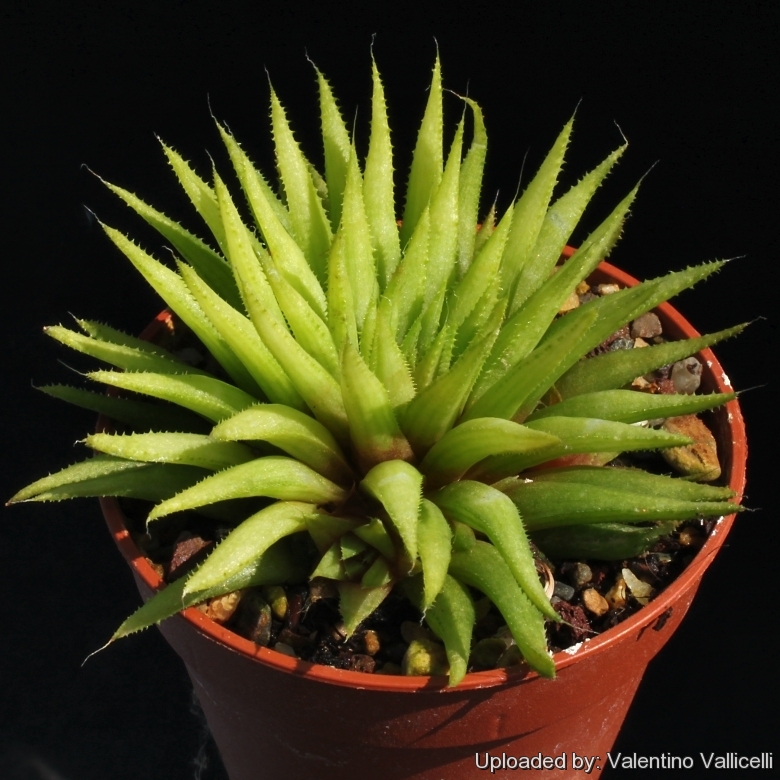
Haworthia chloracantha Photo by: Valentino Vallicelli
Origin and Habitat: South Africa. Western Cape ( Swellendam, Herbertsdale, Schoemanshoek)
Habitat: It grows on rock outcrops above steep loose conglomerate cliffs in tiny shallow soil among moss and lichen encrusted patches, often on the shade of bushes. In habitat this plant hybridize quite freely with Haworthia parksianaSN|22535]]SN|22535]].
Synonyms:
See all synonyms of Haworthia chloracantha
Description: Haworthia chloracanthaSN|16856]]SN|16856]] is a very striking small species that suckers profusely and forms dense groups of rosettes.
Stem: Stemless.
Rosette: Small 2,5-6(-8) cm in diameter, open, with 18 to 25 stiff leaves often with a deep red centre.
Leaves: 3,5-4 cm long, slender, lanceolate-accuminae, erect, not spreading, mid or pale green to yellowish green, fleshy, firm in texture, but the distal third often dried and brown; margin and keel, not lineate, unevenly and finely serrated with small teeth the same colour as the leaf or darker.
Flowers: Whitish.
Subspecies, varieties, forms and cultivars of plants belonging to the Haworthia chloracantha group
 Haworthia chloracantha Haw.: It is a low growing heavily suckering succulent that forms crowded clusters. Has small rosettes wit with 18 to 25 stiff, erect, yellowish green leaves.
Haworthia chloracantha Haw.: It is a low growing heavily suckering succulent that forms crowded clusters. Has small rosettes wit with 18 to 25 stiff, erect, yellowish green leaves.- Haworthia chloracantha var. denticulifera (Poelln.) M.B.Bayer: Rosette smaller, leaves spiny, dark green or purplish green. It clumps readily and form mats of green, serated spikes.
- Haworthia chloracantha var. subglauca Poelln.: Rosette more robust, leaves blue-green. The leaves are erect and greyish to reddish green with distinctly toothed margins and form small, dense groups of rosettes.
Bibliography: Major references and further lectures
1) Urs Eggli “Illustrated Handbook of Succulent Plants: Monocotyledons” Springer, 2001
2) Charles L. Scott “The genus Haworthia (Liliaceae): a taxonomic revision” Aloe Books, 1985
3) Stuart Max Walters “The European Garden Flora: Pteridophyta, Gymbospermae, Angiospermae-Monocotyledons” Cambridge University Press, 1984
4) M. B. Bayer “The new Haworthia handbook” National Botanic Gardens of South Africa, 1982
5) John Pilbeam “Haworthia and Astroloba: A Collector's Guide” B. T. Batsford Limited, 1983
6) Gordon D. Rowley “The illustrated encyclopedia of succulents” Crown Publishers, 01/Aug/1978
7) Raimondo, D., von Staden, L., Foden, W., Victor, J.E., Helme, N.A., Turner, R.C., Kamundi, D.A. and Manyama, P.A. 2009. “Red List of South African Plants” Strelitzia 25. South African National Biodiversity Institute, Pretoria.
Cultivation and Propagation: Haworthia are of easy cultivation and relatively low maintenance, which makes them a good houseplant, and can be an excellent subject for the beginning succulentophile (they can grow easily on window sills, verandas and in miniature succulent gardens where they are happy to share their habitat with other smaller succulent plants, or in outdoor rockeries). Haworthias are winter growers and are dormant in the hottest summer months.
Growth rate: They are relatively fast-growing plants that offsets freely to form small clusters quickly.
Soil: They are tolerant of a wide range of soils and habitats, but prefer a very porous potting mix to increase drainage. A non-acid soil is ideal. You can grow a plant in a 10-15 cm pot for years and have perfectly happy plants. For best results, use a shallow pot.
Exposition: The plant needs light shade to shade, but will take full sun part of the day. (with some sun exposure the leaf develops a nice reddish tint and remains compact)
Watering: During the hot summer months, the soil should be kept moist but not overly wet. During the winter months, water only when the soil becomes completely dry. Wet soil quickly causes root and stem rot, especially during chilly winter months. . No water should ever be allowed to stand around the roots. Low ambient humidity is always needed.
Fertilization: The plants are fertilized only once during the growing season with a balanced fertilizer diluted to ½ the recommended strength.
Hardiness: Although the plant will survive mild frost if kept dry (hardy as low as -5° C) it should be protected from severe cold and prolonged frost conditions.
Rot: Rot is only a minor problem with Haworthia if the plants are watered and “aired” correctly. If they are not, fungicides won't help all that much. Care must be given in watering, keeping them warm and wet while growing, and cooler and dry when dormant.
Remarks: Haworthias are best planted in a shaded and airy part of the greenhouse, and not too close to the glass roof or sides of the house as the plants can overheat during hot spells.
Propagation: Haworthia are easily propagated by the removal of offshoots in spring or summer. They can also be grown from seed.











